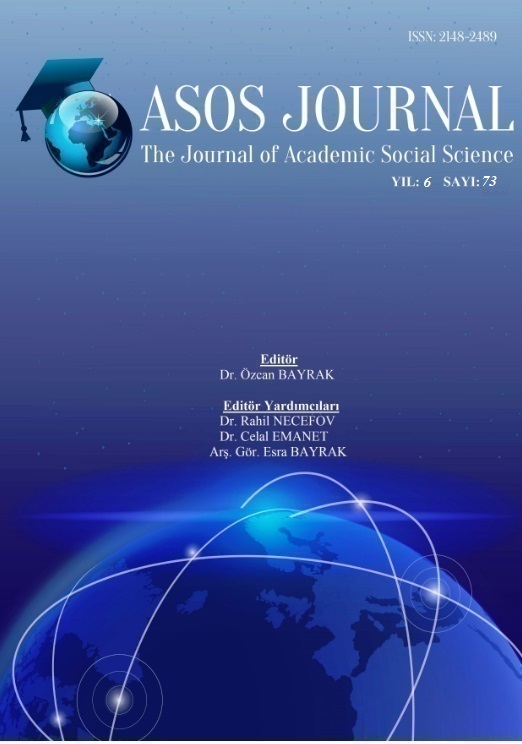Author :
Abstract
Hızla gelişen dünyada farklı dili konuşan insanlar arasında iletişim ihtiyacı arttıkça yabancı dil öğrenme ihtiyacı da artmış ve yabancı dili daha kolay öğrenmenin yolları araştırılmaya başlanmıştır. Bu düşünceden hareketle bu çalışma; iki ayrı dil ailesine mensup olan Türkçe ve Almanca birleşik cümle yapılarının, farklı ve benzer yönlerini karşılaştırmalı dilbilim yöntemi açısından tespit ederek, Türkçenin Almanlara yabancı dil olarak öğretimini kolaylaştırmayı amaçlamıştır. Bu durumda Türkçeyi öğrenen Almanların kendi dillerinde bulunan benzer bir yapıyla karşılaşmaları, öğrenmeyi kolaylaştırması açısından önem arzetmektedir. Çalışmada; ilk olarak ‘Germen dilleri koluna ait olan Almanca ve Ural-Altay dillleri gurubuna ait olan Türkçe, birleşik cümle yapıları açısından hangi farklılık ve benzerliklere sahiptir?’ sorusuna cevap aranmıştır. Çalışma; Türkçe’de cümle çeşitlerinden yapısına göre cümleler sınıflandırmasında yer alan birleşik cümle ve çeşitleri olan; şartlı birleşik cümle, iç içe birleşik cümle ve ki’li birleşik cümle, Almanca’da cümle çeşitlerinden birleşik cümle (Zusammengesetzter Satz) ve çeşitleri olan yanyana birleşik cümle (Nebenordnende), alt alta birleşik cümle (Unterordnende), soru adıllı birleşik cümle (Interrogativsatz) ve ilgi cümlesi (Relativsatz) karşılaştırılması ile sınırlandırılmıştır. Bu çalışma betimsel bir araştırmadır ve karşılaştırmalı dilbilimi yöntemi kullanılmıştır. Türkçe ve Almanca birleşik cümlelerin karşılaştırılması için her iki dile ait temel dilbilgisi kitapları temin edilmiştir ve Peyami Safa´nın “Yalnızız” adlı Türkçe ve Siegfried Lenz´in “Deutschstunde” adlı Almanca olan iki tane roman örnek cümleler için kullanılmıştır. Her iki dilde cümle tasnifi ve birleşik cümle yapısı karşılaştırmalı dilbilim yöntemine göre karşılaştırılıp, aradaki fark ve benzerlikler tesbit edilmiştir. Sonuç olarak;Türkçe ve Almanca birleşik cümlelerde tanımlar ve sözdizimi arasında birçok benzerliğin yanında farklar da tesbit edilmiştir. Ki’li birleşik cümle Türkçeye Hint-Avrupa dil ailesine mensup olan Farsçadan geçmiş olması yönüyle, Almanca’da çok sık kullanılan birleşik cümlelerle benzerlik göstermektedir. Türkçe örneklerde görüldüğü gibi Kİ cümlesi hariç birleşik cümlenin yan cümleleri başta yer alır ve temel cümle sonda yer alırken Almanca birleşik cümlelerin temel cümleleri başta yan cümleleri ise sonda yer almaktadır. Almanca alt alta birleşik cümleler başlığı altında değerlendilen Temporale Nebensätze (Zaman Belirten Yan Cümle) cümlesinin yan cümlesi temel cümlesinden sonra yer alırken bu cümle türüne denk gelen Türkçe zarf unsuru temel cümlenin unsuru sayılır ve yüklemden sonra yer almaktadır. Bu tesbitlerden yola çıkılarak Türkçe’nin öğrenilmesinde kolaylık sağlaması açısından tavsiyelerde bulunulmuştur.
Keywords
Abstract
As the need for communication among people speaking different languages increases in the rapidly developing world, the need for learning foreign languages has increased and the ways of learning foreign languages have begun to be studied more easily. With this thought moving this study; aimed at facilitating teaching Turkish as a foreign language to the Germans by identifying the different and similar aspects of the Turkish and German combined sentence structures belonging to two separate language families in terms of comparative linguistic method. In this case, the Germans who learn Turkic language encounter a similar structure in their own language and it is important to facilitate learning. Study; first of all, what kind of differences and similarities do they have in terms of Turkish, compound sentences belonging to the German and Ural-Altaic language groups belonging to the "Germanic languages"? Work; The sentences and their varieties which are included in the classification of sentences according to the structure of the sentences in Turkish; a compound sentence with a variety of sentences in German (Zusammengesetzter Satz), a combined sentence with its variants (Nebenordnende), a lower alta unified sentence (Unterordnende), a question compound sentence (Interrogativsatz ) and interest (Relativsatz). This study is a descriptive research and comparative linguistics method is used. Basic grammatical books of both languages have been provided for the comparison of Turkish and German compound sentences and have been used for Peyami Safa's "Lonely" in Turkish and Siegfried Lenz's "Deutschstunde" in German for two sample sentences. The differences between the sentence structure and the compound sentence structure on the two sides were compared according to the comparative linguistic method and the differences and similarities were determined. As a result, in Turkish and German compound sentences, definitions and syntaxes have been identified in addition to many similarities. The compound sentence of Ki is similar to the compound sentences which are frequently used in German, in the sense that the Turkic language belongs to the Indo-European language family, Persian. As seen in the Turkish examples, except for the KI, the side sentences of the compound sentences are at the head and the basic sentences of the German compound sentences are at the end, while the side sentences are at the end. The German envelope element corresponding to this sentence is considered as an element of the basic cümlen and takes place after the predicate while the Temporal Nebensätze (Time Sentence Side Sentence), which is evaluated under the heading of the German sub-alta joint sentences, takes place after the side sentence basic sentence. From these determinations, some suggestions have been made in terms of facilitating the learning of Turkish.





